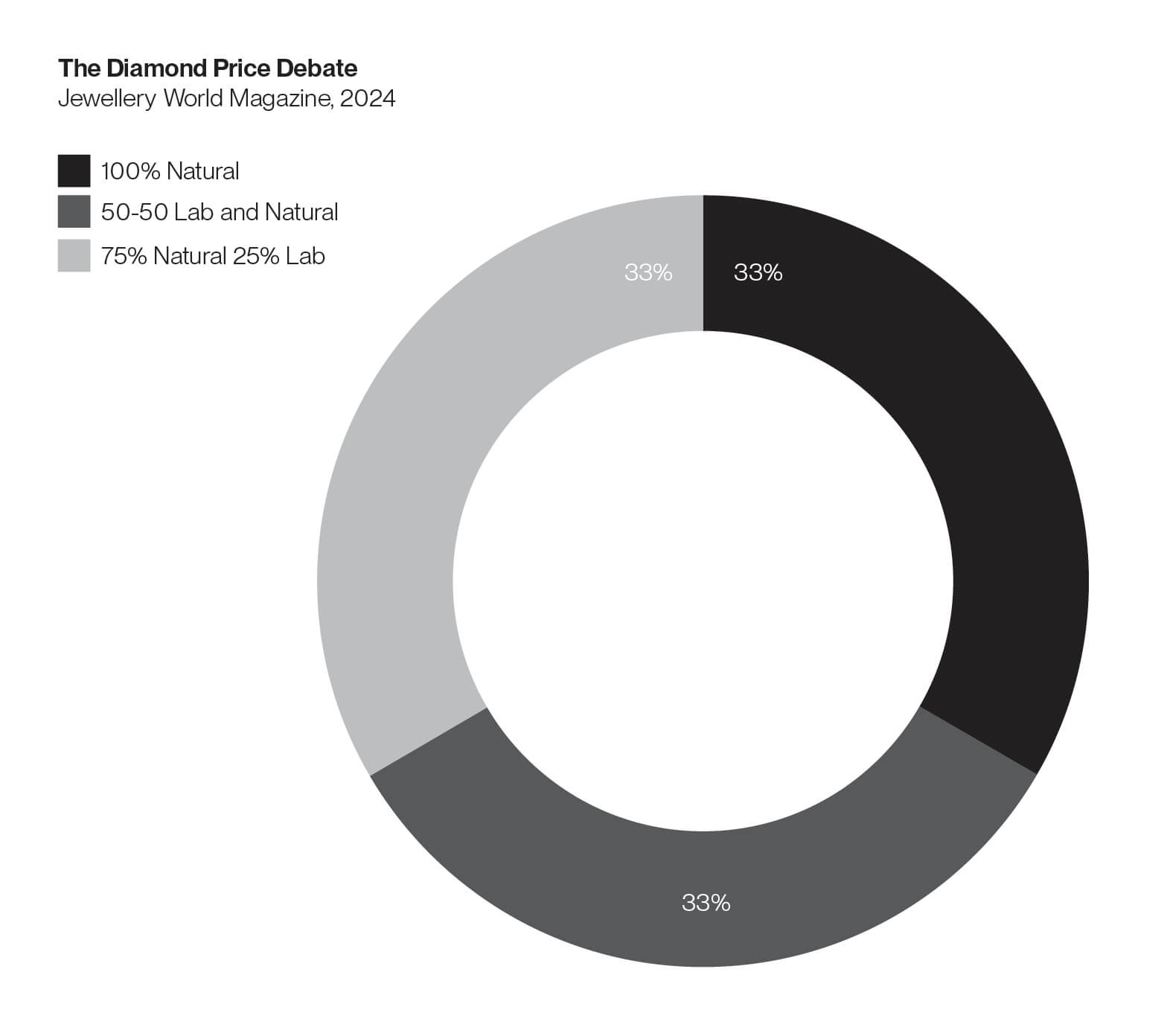As the diamond industry continues to sparkle with innovation and change, understanding the shifting prices and preferences between natural and lab-grown diamonds becomes increasingly vital for businesses aiming to thrive in this dynamic market.
Understanding and adapting to market fluctuations is essential for success in the diamond trade. JW recently conducted an in-depth survey among retailers, jewellers and wholesalers to explore how they are managing the impact of changing diamond prices. Featuring insights from some industry leaders, we delve into current pricing strategies, consumer preferences, and the ongoing debate between lab-grown and natural diamonds.
Impact of Price Fluctuations
The survey revealed a varied impact of diamond price fluctuations on business operations across the industry. Many respondents reported a slight decrease in sales as a direct result of these fluctuating prices, reflecting the overall sensitivity of the market to changes.
For instance, David Hollanders, partner at Wildtrout Designer Jewellers, mentioned experiencing slightly decreased sales, highlighting the moderate decline felt by some businesses. However, a notable segment of respondents experienced a more significant drop in sales, underscoring the challenges faced by certain businesses in adapting to price volatility in uncertain financial times. Nirav Shah, director at Affection Diamonds also noted significantly decreased sales, pointing to the substantial impact price fluctuations can have on companies throughout the trade chain.
Interestingly, a few businesses reported stable sales despite the price changes, indicating that some companies have successfully implemented strategies to mitigate the effects of price fluctuations. Parys McClean, director at Diamond Collective, reported no significant impact on sales, showcasing the effectiveness of its adaptive strategies and inventory.
Pricing Strategies
To manage the impact of fluctuating diamond prices, businesses have adopted flexible pricing strategies. This often includes adjusting profit margins, with some opting to reduce margins to stay competitive. Nirav Shah explained his approach: “Reducing the profit margins.” Others maintain stable margins and pass cost changes directly to customers. David Hollanders stated, “I work on the same margins I have [always] done––cheaper prices flow through to the customer.”
Enhanced inventory management has also been a crucial strategy, with businesses carefully managing stock levels to align with current market conditions and consumer demand. Cheri Brunt, chief executive officer of Bell & Brunt, noted, “We have adjusted the amount of diamond stock we would normally carry,” emphasising the importance of inventory management in navigating price fluctuations.

Consumer Preferences
The results revealed shifts in consumer preferences due to price changes. Many respondents noted an increased demand for lower-priced diamonds, reflecting a shift towards more budget-conscious purchasing decisions. Dr Adriana Traviati, managing director of Saphira International, observed an “increased demand for lower-priced diamonds,” highlighting the changing consumer behaviour.
However, some respondents observed that consumer preferences have remained stable despite price fluctuations, suggesting a segment of the market remains committed to their preferred types of diamonds regardless of cost. Cheri Brunt mentioned, “No noticeable change in consumer preferences,” indicating that some consumers continue to prioritise their preferences over price considerations.
Natural vs. Lab-Grown Diamonds
The ongoing debate between natural and lab-grown diamonds is a significant theme in the current market. Many respondents reported that natural diamonds remain in higher demand. Dr Adriana Traviati stated, “I proudly hold zero [percent] lab-grown,” reflecting a strong preference for natural stones. Similarly, David Hollanders noted that natural diamonds are in higher demand among his customers.
However, there is also a noticeable trend towards lab-grown diamonds. Parys McClean from Diamond Collective observed, “More clients are opting for lab-grown,” indicating a growing acceptance and preference for lab-grown options among certain consumer segments. This sentiment was echoed by an anonymous jeweller, who mentioned an increasing demand for lab-grown diamonds.
While price is often cited as a primary factor driving the popularity of lab-grown diamonds, consumer motivations can vary widely. Some consumers may be drawn to lab-grown diamonds due to their lower cost compared to natural diamonds. Others may appreciate the technological innovation behind lab-grown diamonds or perceive them as a more sustainable and ethical choice. As the industry continues to innovate and adapt, understanding these dynamics will be essential for businesses to effectively meet the diverse needs and preferences of their customers.
Sourcing Challenges
Sourcing challenges also vary between lab-grown and natural diamonds. While some respondents reported no significant issues in sourcing natural diamonds, others highlighted difficulties in obtaining specific sizes and cuts. Cheri Brunt noted, “Natural diamonds in 1.20+ are becoming rarer and rarer. Even in round brilliant cut, we are finding it harder to source availabilities in the larger sizes.” In terms of lab-grown diamonds, businesses like Diamond Collective have encountered challenges in sourcing more unusual shapes, requiring custom cuts to meet client demands.
Future Outlook
The future of the diamond industry remains a topic of debate among respondents. Dr Adriana Traviati expressed optimism about natural diamonds, stating, “I believe we are at a critical inflexion point, where the shine of lab-grown diamonds is wearing off, and consumers are heading back to natural.” On the other hand, an anonymous jeweller emphasised the growing demand for lab-grown diamonds and the need for the industry to adapt to consumer preferences: “A lot of industry leaders have [snubbed] lab-growns for so long, but the growing demand shows that consumers want what they want.”
Overall, the survey highlights the resilience and adaptability of the diamond industry in the face of price volatility. Retailers, jewellers and wholesalers are employing a range of strategies to navigate these challenges, ensuring they remain competitive while meeting consumer needs. The diverse responses illustrate the industry’s commitment to maintaining stability and growth amidst fluctuating market conditions. As David Hollanders put it, “Integrity has to be more important than short-term sales,” encapsulating the industry’s dedication to long-term success.


